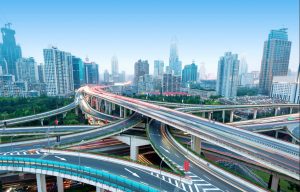Successful smart city projects are scarce. An excessively one-sided approach to complex issues and a fragmentation in stakeholders create an ideal breeding ground for failure. Moreover, the term is now used for lots of things, and so any practical possibilities remain vague. Who will take the initiative? Who will invest? A 3D platform for simulating a complete smart city provides a solution.

Smart city projects often focus on one single aspect, like improving the traffic flow on a busy road, decreasing waste flows, or a more efficient response to emergency calls.
Forming Silos
This forming of silos impedes success. Urban environments form a hugely complex interaction of factors with a high level of cohesion. These factors can influence one other – unintentionally and suddenly – both positively and negatively.
An improved traffic flow can positively effect safety, for instance as emergency services can be onsite faster. Or vice versa: perhaps the smart noise barrier constructed for less noise alongside the rail tracks might actually increase safety risks, as the barrier blocks both the view and daylight. Those who fail to recognise this ahead of time will miss out on valuable opportunities, and could end up making the wrong decisions.
Solution: 3D Platform
Fortunately, there is a smart solution for this, too. Using special software, you can create a complete 3D replica of a city, where you can zoom in as much as you want, and are able to navigate through the town with a drone perspective view. We call this a ‘3DEXPERIENCity’. This software does not only replicate the physical layer, but also integrates the data layer, resulting in a real time representation of reality.
A real time 3D model of the city provides yet another advantage: it also acts as a collaborative platform. All of the stakeholders can then see and experience the impact of certain choices on the living environment.
Experience
There is yet another reason why a city council based on data silos is not entirely effective. Figures might provide an insight, but they do not offer the human ‘experience factor’. A 3D model that comes as close as possible to reality, however, does provide this factor, certainly when you can visit a virtual city wearing virtual reality glasses.
Involve Citizens
This is also a perfect opportunity to engage citizens in urban development. Invite them for a virtual tour through their ‘new’ city, and get them involved. A 3D simulation makes this more accessible and appealing than ever for citizens. Instead of looking at abstract construction drawings, they can actually walk around their new city park, revamped centre, or experience a new traffic situation.
In Practice
3DEXPERIENCity’s are no longer a distant prospect. An interactive 3D model of the Breton city of Rennes has already been developed. The city uses the simulation in such a way that its citizens can experience urban projects in advance, giving them a greater say.
https://www.youtube.com/watch?v=jeee4OwOPEc
Architects also use the virtual replication to simulate sunlight and acoustics. In this way, all stakeholders can see beforehand how new buildings and trees will change the incidence of light and urban sounds, so that these important factors for a good quality of life will not lead to unpleasant surprises afterwards.
Singapore has also discovered the benefits of a 3DEXPERIENCity with the ‘Virtual Singapore’ project. Just like Rennes, the city-state is able to visualise solutions, and optimise these using ‘what if’ simulation. Singapore can, for example, generate insight into the effects of floods, and develop precautions. It can furthermore assess the consequences of constructing a new stadium or motorway for air quality, environmental noise, and pollution, and take additional measures whenever necessary.
https://www.youtube.com/watch?v=8adjfS2D4zE
According to the UN, two thirds of the global population will be living in cities in 2030. Solving urban issues therefore deserves the highest priority. Advanced technology creates new opportunities. We are selling ourselves short if we don’t make smart use of these opportunities.

